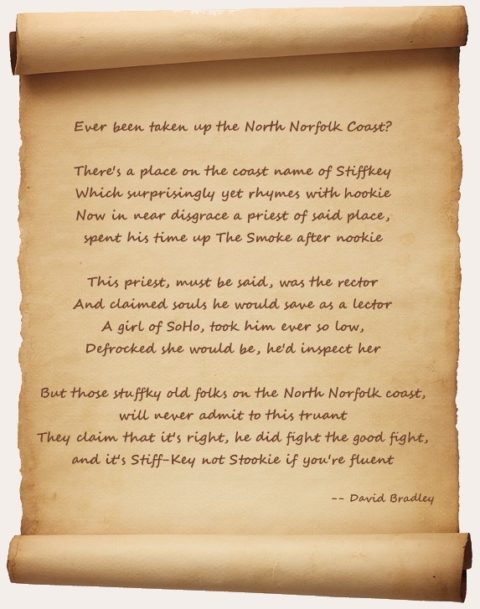A man tries to convince his friend that Charles Darwin conceived his book ‘Origin of Species’ on the concept of evolution in the town of Cromer, Norfolk, England and not in the Galapagos Islands. This video was premiered at the first Science Online conference back in 2009 but has only just this last week reached the virtual hallowed halls of Youtube. Thanks to Graham Steel for the alert. I knew I’d seen it somewhere before…
Meanwhile, for fans of the North Norfolk Coast, here’s a little poem wot I wrote about the village of Stiffkey.

Ever been taken up the North Norfolk Coast?
There’s a place on the coast name of Stiffkey
Which surprisingly yet rhymes with hookie
Now in near disgrace a priest of said place,
spent his time up The Smoke after nookie
This priest, must be said, was the rector
And claimed souls he would save as a lector
A girl of SoHo, took him ever so low,
Defrocked she would be, he’d inspect her
The village was shocked but kept quiet
’bout those happenings, they’d cause a riot
in the street and the lane where the people are plain
But the papers they scooped that old the story quite righ-ut
A court case was held, “Immoral!” they yelled and the rector was morally shaken
thrown out of the church but escaping the birch
he frowned as reached Stiffkey quakin’
But those stuffky old folks on the North Norfolk coast,
will never admit to his truancy
They claim that it’s right, he did fight the good fight,
and it’s Stiff-Key not Stookie if you’ve fluency
Incidentally, the Rev Dr Ezekiel Gee (played by Henry Gee aka CromerCrox) is not the Rector of my poem.
 When you’re feeling blue, put on a sad song. Getting in the party spirit? Turn up the dance music. We are all well aware that music can fit our mood and even reinforce certain emotions. Now, researchers at Philips Research in The Netherlands have demonstrated that background music can affect our mood even while we are directly focused on another task. Their work, described in the International Journal of Human Factors and Ergonomics might have implications for those investigating the benefits of music therapy, music in the workplace, commercial environments or even in healthcare.
When you’re feeling blue, put on a sad song. Getting in the party spirit? Turn up the dance music. We are all well aware that music can fit our mood and even reinforce certain emotions. Now, researchers at Philips Research in The Netherlands have demonstrated that background music can affect our mood even while we are directly focused on another task. Their work, described in the International Journal of Human Factors and Ergonomics might have implications for those investigating the benefits of music therapy, music in the workplace, commercial environments or even in healthcare. TouchPress has done it again giving us an aesthetically pleasing collision of art and technology – akin to the Leonardo Anatomy app I mentioned a while back. This time The Sonnets by William Shakespeare gets the modern treatment with videos and readings featuring Patrick Stewart (always a draw for the Trekkie classicist), Stephen Fry (for the Apple fanboys) and David Tennant (for the Whovians) and Kim Cattrall (who was in the TV series of Logan’s Run, of course) and others. All 154 pieces are performed to camera by the all-star cast.
TouchPress has done it again giving us an aesthetically pleasing collision of art and technology – akin to the Leonardo Anatomy app I mentioned a while back. This time The Sonnets by William Shakespeare gets the modern treatment with videos and readings featuring Patrick Stewart (always a draw for the Trekkie classicist), Stephen Fry (for the Apple fanboys) and David Tennant (for the Whovians) and Kim Cattrall (who was in the TV series of Logan’s Run, of course) and others. All 154 pieces are performed to camera by the all-star cast.

 There’s a weird piece of Deceived Wisdom that emerged from so-called Neuro-Linguistic Programming (NLP) that suggested that one could somehow tell whether a person was lying by looking at their eye movements. Turns out, unsurprisingly, that it’s nonsense. All that guff about looking up to their right when you’re fabricating a tale and down to the left when they’re recalling a truth? It’s nonsense.
There’s a weird piece of Deceived Wisdom that emerged from so-called Neuro-Linguistic Programming (NLP) that suggested that one could somehow tell whether a person was lying by looking at their eye movements. Turns out, unsurprisingly, that it’s nonsense. All that guff about looking up to their right when you’re fabricating a tale and down to the left when they’re recalling a truth? It’s nonsense.